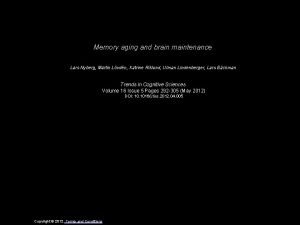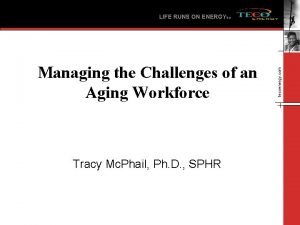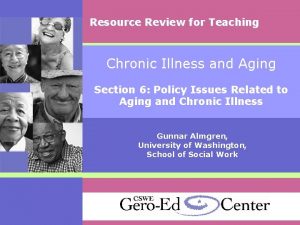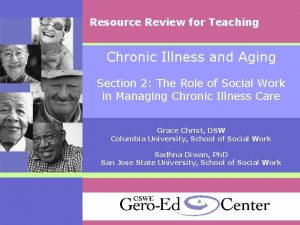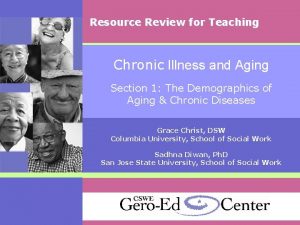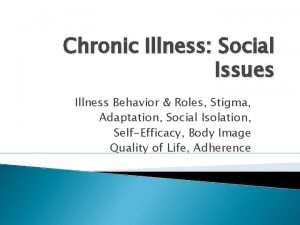Resource Review for Teaching Chronic Illness and Aging









- Slides: 9

Resource Review for Teaching Chronic Illness and Aging Section 3: Typology of Chronic Illness and Impact on the Family Gunnar Almgren, Ph. D University of Washington, School of Social Work Sadhna Diwan, Ph. D San Jose State University, School of Social Work

SYNOPSIS § Chronic illness is a term applied to a broad range of diseases that vary greatly both in their essential characteristics and the ways in which a given disease affects the family system and its adaptive functioning. To understand the most critical ways a chronic disease affects not only the family system as a whole but also the individual family members, one must consider the key characteristics of both the disease and the family system (Rolland, 1994). In this section Rolland’s typology of chronic diseases is described; the impacts of the chronic disease on the family’s instrumental functions as a social unit; and the impact of critical components of family functioning, i. e. , family structural and organizational patterns, communication processes, multigenerational patterns and the family life cycle, and family belief systems are examined.

TYPOLOGY OF CHRONIC ILLNESS AND IMPACT ON THE FAMILY § § Topics Covered A Typology of Chronic Disease § Chronic Illness and the Family Systems of Older Adults: Domains of Impact § Family Tasks and Responsibilities in Caring for Older Persons § Impact of Chronic Disease on the Family § Impact of Family on Health Outcomes of Older Adults

A Typology of Chronic Disease Four Key Dimensions in a Psychosocial Typology of Disease: 1. Onset: (Acute vs. Gradual) 2. Course of Disease Process (Progressive, Constant or Relapsing) 3. Outcome (Non-fatal, Shortened Life Span, or Fatal) 4. Incapacitation (Range from None-Mild-Moderate -Severe) Source: Adapted from Rolland. Families, Illness and Disability. Basic Books 1994.

Chronic Illness and the Family Systems of Older Adults § The prevalence of chronic disease is highest among oldest adults. § At least 80% of people older than 60 are living with one chronic illness. § 50% of people older than 60 are living with two chronic illnesses. * § Chronic conditions can cause years of pain, disability, loss of function, and loss of independence, often at a pace can be greatly influenced by malleable social and behavioral factors, including: § § § specific attention to critical health behaviors an adequate network of social supports access to quality health care. § All of the above malleable factors are heavily mediated by structures and processes within the family system

Chronic Illness and the Family System Domains of Impact § Viability as an Economic Unit that Provides for the Essential Material Needs of Family Members. § Ability to Meet the Developmental Needs of Individual Family Members at Various Stages of the Life Course. § Capacity to Function as the Primary Care and Support System for Ill and Disabled Family Members.

Family Tasks and Responsibilities in Providing Care to Older Persons § Logistics, care management, and medical decision-making. E. g. scheduling medical appointments, providing transportation, handling billing questions. § Presenting the patient’s history, listening to the clinicians’ assessments and instructions. Making, or influencing decisions regarding the appropriate course of treatment; Monitoring the older person’s health status. § Taking on the role of health care provider, providing assistance with the activities of daily living. § Advocating on the patient’s behalf and to enhance the providers’ understanding of the older adult’s social environment, health conditions, and care preferences. § Family members’ understanding of the providers’ treatment recommendations and their ongoing interactions with the patient at home and in the community can influence the patient’s behaviors, treatment adherence, and health. § Serving as interpreters to health care providers when older adults do not speak English. An estimated 79% of hospitals rely frequently on family and friends to serve as interpreters (Wilson-Stronks & Galvez, 2007).

Impact of Chronic Disease on the Family: Domains of Family Functioning A chronic disease can adversely affect the family’s instrumental functions in a variety of ways: 1) Family Structural/Organizational Patterns 2) Communication Processes 3) Culturally Specific Multigenerational Patterns and Family Life Cycle 4) Family Belief Systems (e. g. , shared constructions of reality, view of family system, world view).

Impact of Family on Health Outcomes of Older Adults § Dementia care outcomes for patients are improved when families are engaged in patient care. § Families enable postponement of institutionalization of the older person and are associated with shorter stays in the hospital. § An absence of adequate caregiving is associated with problematic hospital discharges or readmissions. § Individuals with few social supports are more likely to have unmet needs in personal care and household tasks and more likely to miss medical appointments and to fail to fill prescriptions. § Patients receiving instrumental help were 3. 6 times more likely to adhere to medical instructions and prescriptions (Di. Matteo, 2004). This was twice as effective as emotional support, which was associated with 1. 8 times greater likelihood of adherence. Individuals with close, cohesive families are 3 times more likely to adhere to instructions than those from conflicted families. § Although the importance of family involvement in the process of health care delivery is recognized, there is still little knowledge about which particular attributes of family involvement are efficacious in improving health outcomes. (Source: IOM, 2008).
 Improving chronic illness care model
Improving chronic illness care model Disability resource center uky
Disability resource center uky Dane county aging and disability resource center
Dane county aging and disability resource center Resource allocation vs resource leveling
Resource allocation vs resource leveling Perbedaan antara resource loading dan resource levelling
Perbedaan antara resource loading dan resource levelling Definitions of micro teaching
Definitions of micro teaching What is the market forms of meat
What is the market forms of meat Jessie emily schofield poem analysis
Jessie emily schofield poem analysis Trends in cognitive sciences
Trends in cognitive sciences Managing the aging workforce challenges and solutions
Managing the aging workforce challenges and solutions








